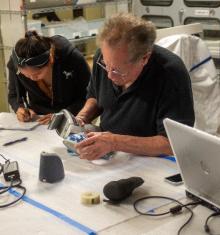Back
Early Ceramics from Southeast Asia: Specimens from Thailand and the Jordan Schnitzer Museum of Art
UO MA archeology student Angelica Kneisly and Department of Anthropology Courtesy Research Associate Maury Morgenstein use non-invasive chemical methods (EDXRF and Raman analysis) to analyze blue-and-white porcelain vessels at the JSMA. Photo by Jonathan Smith.
Early Ceramics from Southeast Asia: Specimens from Thailand and the Jordan Schnitzer Museum of Art
February 15, 2020 to June 13, 2021
This exhibition, organized by UO Department of Anthropology Professor William S. Ayres with the assistance of MA archeology student Angelica Kneisly and Department of Anthropology Courtesy Research Associate Maury Morgenstein, compares archaeological potsherds from fieldwork in Thailand and ceramic objects from the Jordan Schnitzer Museum of Art. This comparison offers new perspectives on the long-distance trade and economic interaction underlying the emergence of colonialism and modern globalism during the fifteenth to eighteenth centuries. Historical records typically provide the documentation for such trade systems. For this presentation, the researchers used non-invasive chemical methods (EDXRF and Raman analysis) to analyze fragments of porcelain trade pieces from a Dutch trading operation at Pattani, south Thailand, and blue-and-white porcelain vessels in the JSMA collection to determine whether their sources were Jingdezhen, China, or other production centers. As a coastal center, Pattani provides an indication of the scale and duration of the maritime trade and its impact on specific ports in the region. This installation, made possible through a JSMA Academic Support Grant, demonstrates how material culture, including small artifacts, can convey the long-term interaction between Chinese kiln production and regional consumption, as well as Middle Eastern and European international markets.
Online Resources:
Chinese Shards Interactive Powerpoint






